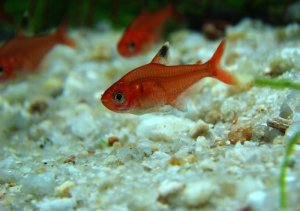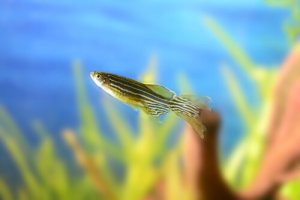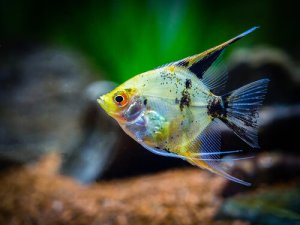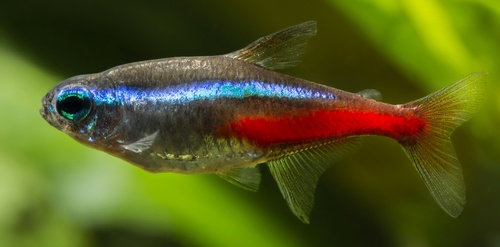
Fish pregnancy and reproduction are surprisingly complex subjects, and it is very often that new fish owners suddenly find themselves with more fish on their hands than they bargained for!
If you are wondering how to tell if you have pregnant Neon Tetra, you’re probably not alone – these small schooling fish breed relatively easily, especially if they feel safe, comfortable, and well cared for in their tank environment. So, read on to understand the ins and outs of Neon Tetra pregnancy, how to spot it, and much more…
How To Tell If You Have Pregnant Neon Tetra
Once you know what you’re looking for, it’s not hard to spot pregnant Neon Tetras. The main things that mark them out are their appearance and behavior, both of which change compared to fish that are not carrying eggs.
1. Observe Changes In Appearance
When they become pregnant, Neon Tetras change their appearance significantly. The biggest thing to notice is the rounded abdomen where they are carrying the eggs.
Later on, this article outlines some common diseases that this distended abdomen can be confused with. However, a good rule is that the abdomen of a pregnant Tetra may stick out very far from your fish’s body, almost the same distance as your fish’s height from its back to its stomach. This can make them unmistakable.
Look At Your Fish From Above
If in doubt, look at your fish from above. Due to the huge number of eggs that female Neon Tetras carry, you will also be able to see her abdomen sticking out from either side of her body.
Author’s Note: At this stage, it’s very easy to differentiate the females from the males. In addition, if you think your fish may be pregnant but you are not sure, checking on how they look from above each day can help you see noticeable changes in their size and shape.
2. Observe Behavioral Changes
Another surefire way of telling whether your Neon Tetra is or is not pregnant is whether they have any noticeable changes in behavior. Neon tetras are generally bold fish, so any tetra that hides away amongst plants or behind rocks tends to have a major change going on. This could be illness, but it can also be pregnancy. Pregnant fish may especially seek out shelter to look for a place to lay their eggs.
Pregnant Neon Tetra Appetite
Appetite can change when your Neon Tetra is pregnant, in more ways than one. Due to the multitude of different hormones coursing through your fish’s body, your tetra will eat more or less. This is normal, but the same rules of feeding apply. Never over or underfeed a fish, always remove uneaten food after five minutes, and ensure all fish are getting food without any bullying.
However, when your fish is pregnant she may need extra protein for energy, and if she seems especially, hungry, for example, swimming up to the surface of the water, you can occasionally add a bit of frozen protein such as brine shrimp to the surface near her so that she can get some more energy.
3. What Factors Cause Neon Tetras To Become Pregnant?
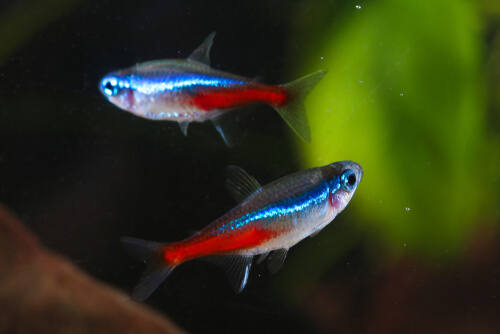
Neon tetras, like many other bony fish, are ovoviviparous, meaning that they grow their eggs inside their body and then spawn, laying them so that the male can fertilize them. This is in contrast to livebearing fish like mollies, platies, guppies, and swordtails, that give birth to live, free-swimming fish fry.
Fish do not need a male to grow the eggs in their uterus but they do need one to fertilize them outside their body. But what causes these eggs to start growing? The process is not yet fully studied, but factors such as lighting, temperature, and other tank conditions all play a complex and interconnected role.
- Lighting
Neon tetras do not like bright lighting at all! This is because in the wild their forested habitat is relatively shadowed by large rainforest trees. In captivity, they can survive under bright lights, but they won’t thrive. If you want to breed your fish, it’s best to recognize that they are most likely to become pregnant in optimum conditions.
- Temperature
A relatively high temperature like 78 F (26 C) is optimal for Neon Tetras to spawn. In the wild, Neon Tetra spawning is seasonal. In captivity, the lack of cues indicating changing of the seasons leads them to spawn at any time of year depending on whether or not other triggers are present.
However, a higher water temperature that mimics this period of their natural habitat definitely doesn’t hurt. Thus, you may sometimes find raising the temperature of your tank a bit triggers tetras to become pregnant and even to start the mating and courtship rituals.
- Seasonality
The effects of seasonality are still relatively unknown even though these are one of the most popular captive-bred fish and are often raised in large farms. However, like with any fish that mates on a seasonal basis, the conditions that are most similar to the beginning of the rainy season are what can influence pregnancy in Neon Tetras. Taking into account their Amazonian habitat, this includes heavy falling rain, heat, and humidity.
Author’s Note: There are no hard and fast studies of the effects of mimicking these on tetra pregnancy and breeding success, but if you want to experiment, it’s always possible to increase the filter flow rate slightly or buy a bubbler to increase oxygenation of the water in the same way that heavy tropical rains would do so in the wild.
What Factors Cause Neon Tetras To Give Birth?
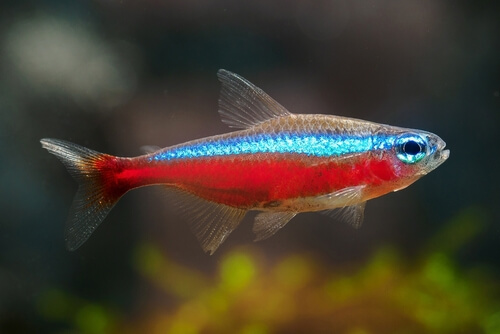
The presence of an eligible male is the biggest factor that causes Neon Tetras to give birth. A pregnant Neon Tetra will be courted by the available males until she shows responsiveness and drops her eggs for him to fertilize.
A safe tank environment also encourages all your Neon tetra’s natural behavior. Whilst they can give birth with other tankmates such as other kinds of tetras in the tank, a separate breeding tank can give them even more encouragement.
However, this process is also affected by and controlled by the factors that control egg creation, such as seasonality, temperature, and lighting, as well.
Author’s Note: The mating dance of the Neon Tetra is great to watch if you are in the right place at the right time. You can see the male chase the female and the pair swim elegantly through the water. This may look like chasing, but generally, there is no nipping or aggression. Instead, the male simply encourages the female to drop her eggs so he can fertilize them.
Common Confusions With Neon Tetra Pregnancy
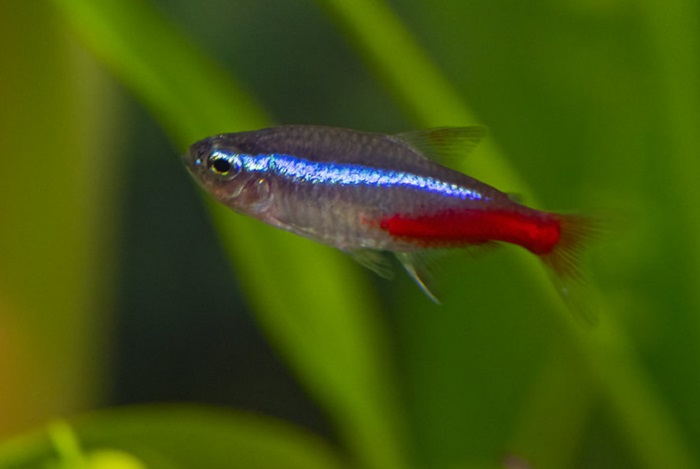
Unfortunately, there are still a few diseases that you can mistake for pregnancy – especially in small fish like Neon Tetras, whose needs can be less easy to read than larger ones like goldfish. Read on for some of the main ones to know about:
1. Dropsy
Sadly, if your fish has dropsy, there’s generally not much you can do about it because this disease tends to be fatal. Treatment isn’t really possible especially once it has progressed into the stage where your fish’s body has changed significantly.
However, it’s worth knowing how to identify it during pregnancy in order to put your mind at rest. Dropsy is especially notable as all your fish’s scales will stand out like a pinecone. It will also show other signs of illness, such as trouble staying afloat and lethargy, as well as loss of appetite.
On the other hand, a pregnant Neon Tetra may on the other hand show an increased appetite and certainly won’t have scales that stand out. Dropsy, like other bacterial infections, comes from poor water quality. If you want to prevent Neon Tetras from dying, it’s best to maintain good water quality.
2. Bloating
Bloating can arise from issues other than Dropsy. For example, one of the most common issues that causes bloating is overfeeding. Overfed fish may also have digestive issues.
It helps not to over or underfeed your fish. Overfeeding fish means food builds up in their digestive tract. Overfeeding generally happens when you feed fish more than once a day and you don’t clean up any food that is still left uneaten after five minutes.
Bloating can also happen if you don’t feed a balanced enough diet and instead only feed fish flakes, or feed pellets that are too dense and indigestible for your fish.
3. Digestive Issues
Apart from bloating, other digestive issues can arise such as constipation or alternatively, your fish’s digestive system being overactive. Sometimes this can come from disease, for example from a bacterial infection, but sometimes it can come from feeding the wrong food.
Neon tetras are omnivorous and feed a mixture of flake or pellet food as well as fresh or frozen protein and the occasional bit of vegetable matter is best for them. No fish can live on flake or pellet food alone!
4. Other Diseases
Other diseases may not cause the larger rounder appearance that is common to pregnancy, but they can cause behavioral changes in your fish that you can easily mistake for pregnancy.
Pregnant fish can and do lose energy, swim with a bit more difficulty, and hide, very similarly to sick fish. However, they won’t show the same obvious signs of illness that a sick fish will show and unless your pregnant fish is also sick, a pregnant Neon Tetra should still have bright eyes, shiny colors, and should not seem too lethargic or listless.
Generally, if a fish is sick as opposed to pregnant its symptoms will get gradually worse and will be present all the time, as opposed to a pregnant fish, where lethargy may improve after feeding. Generally, once you have experience with Neon Tetras, you will be able to tell the difference between sick and pregnant fish.
How To Look After A Pregnant Neon Tetra Properly
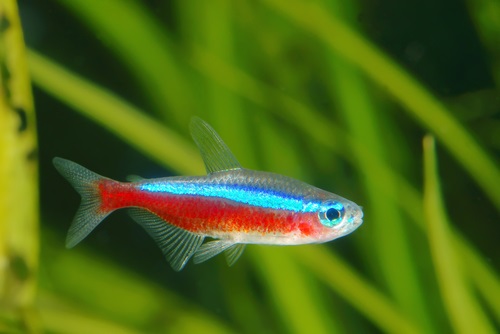
Neon tetras are hardy fish, but that doesn’t mean they don’t still need attention in the way more sensitive species do. Keeping a close eye on your Neon Tetra’s behavior is a good way of checking that everything is going according to plan with the pregnancy.
How To Tell If Your Pregnant Neon Tetra Is Going To Lay Eggs?
There are no hard and fast rules about when a pregnant Neon tetra will lay eggs. However, you may begin to notice behavior such as hiding in and amongst plants as well as generally noticing your fish looking for a safe place away from tankmates.
Female Neon Tetras will often choose plants or driftwood to lay their eggs on or nearby as these provide shelter for them, ensuring that the eggs don’t get eaten by predators.
What Do Neon Tetra Eggs Look Like?
Neon tetra eggs can be hard to spot! They look like very small, clear, round balls. You may see them hanging off the stems of planta or the undersides of plant leaves, or, alternatively, on the glass of the aquarium tank.
How To Tell If Neon Tetra Eggs Are Fertilized?
Luckily, it’s easy to tell when Neon Tetra eggs are fertilized. The small, crystal-clear balls will turn an opaque white.
Bottom Line
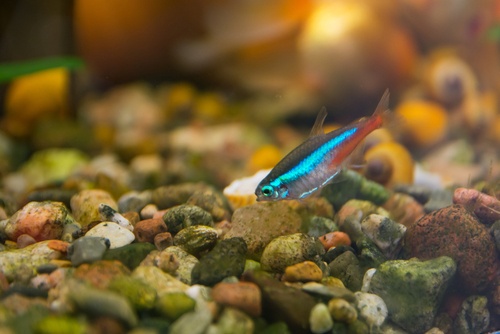
In the end, it’s not really too hard to tell whether you have pregnant Neon Tetra or not. However, what’s important is once your fish are pregnant, you know what to do. Neon tetras are easy fish to breed, and as a result, this is one of the most popular species for beginner aquarists both to keep and to breed, meaning that if you are careful, you will soon have many more fish on your hands.


